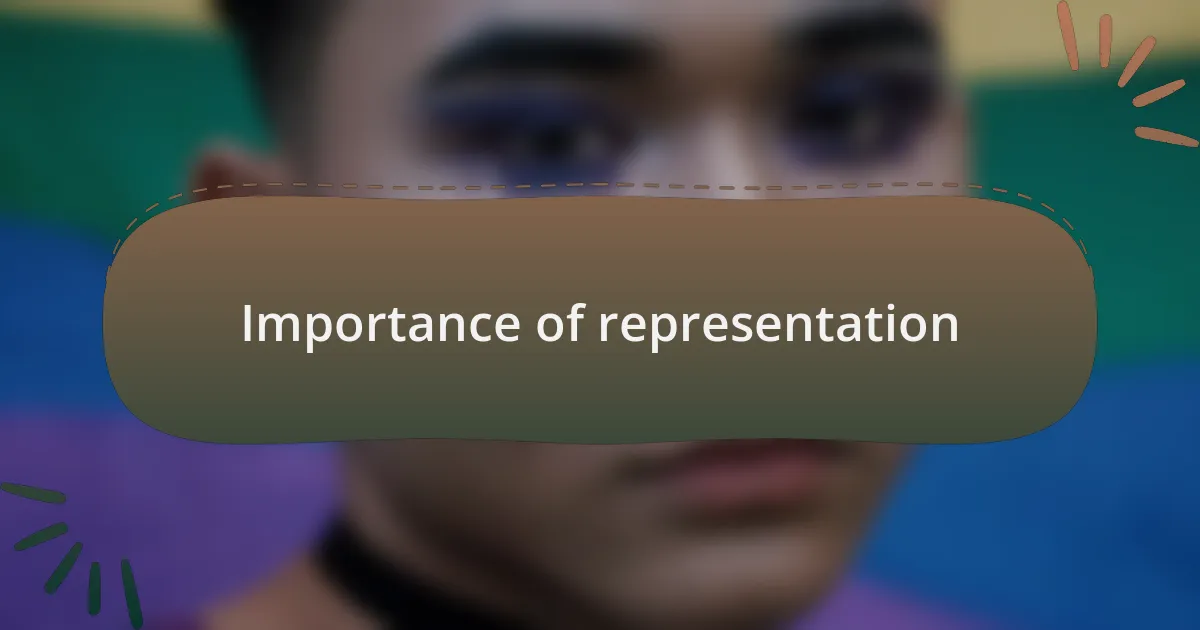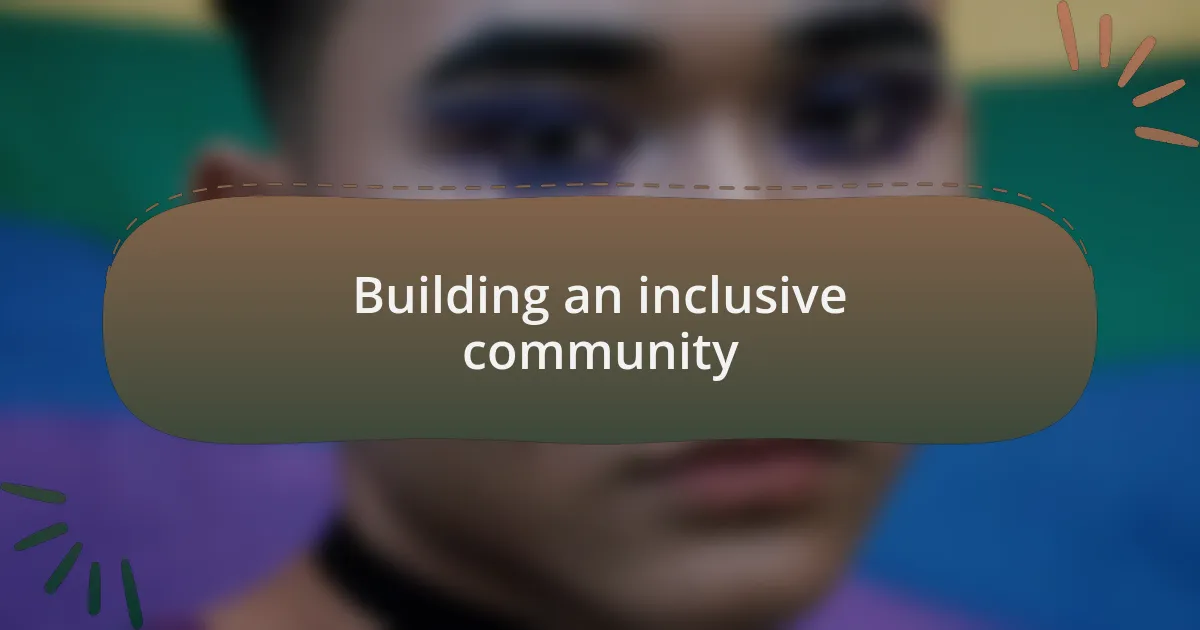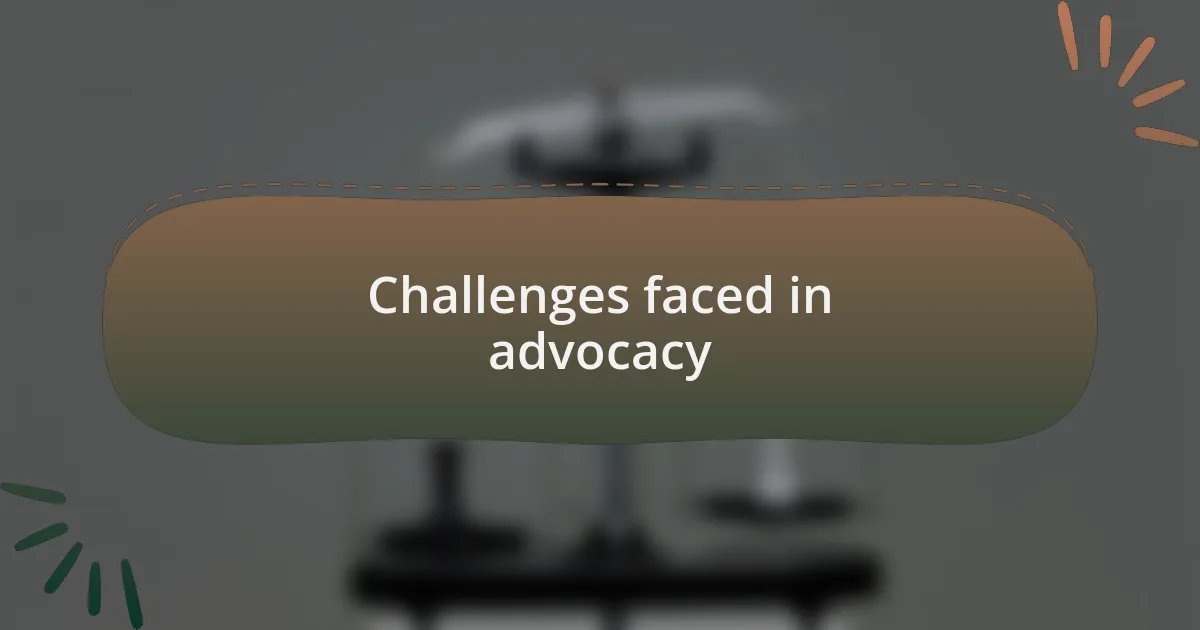Key takeaways:
- Gender equality advocacy is essential for societal growth, requiring tangible actions to challenge stereotypes and address systemic barriers.
- Representation in leadership and media fosters empowerment and belonging, inspiring future generations to envision themselves in diverse roles.
- Storytelling and building coalitions are effective strategies for advocating representation and amplifying underrepresented voices in various spaces.
- Creating an inclusive community involves fostering vulnerability and actively listening to diverse perspectives, enriching the advocacy efforts and overall environment.

Understanding gender equality advocacy
At its core, gender equality advocacy is about ensuring that all individuals, regardless of gender, have equal rights, opportunities, and obligations. I remember attending a community meeting where someone asked, “Why does this matter?” It struck a chord with me because it illustrated a common misconception—equality isn’t just a women’s issue; it’s a societal necessity that enriches everyone’s lives.
Advocacy is more than just talking; it’s about creating tangible change by challenging stereotypes and dismantling systemic barriers. I once organized a local workshop to raise awareness about the importance of equal pay. The participants shared their stories of frustration and triumph, which added a raw, emotional layer to the conversation. It was a stark reminder that behind statistics are real lives—and those stories fuel passionate advocacy.
Moreover, effective gender equality advocacy requires a nuanced understanding of intersectionality, which acknowledges that various social identities interact and shape individual experiences. I often reflect on how this concept deepened my understanding of advocacy. It made me realize that to truly support one another, we need to listen and amplify the voices of those who face multiple layers of discrimination. How can we claim to advocate for all if we overlook the complexities of each other’s experiences?

Importance of representation
Representation plays a pivotal role in shaping societal norms and perceptions. I recall a moment when I watched a panel discussion featuring women from diverse backgrounds. Seeing their experiences and achievements in the spotlight not only inspired me but also highlighted the immense power of visibility. It made me think: how often do we underestimate the influence of representation on our beliefs and aspirations?
When people see themselves reflected in leadership roles, media, and other public spheres, it fosters a sense of belonging and empowerment. I remember a young girl at a community event who beamed with pride as she spoke about her dreams of becoming an engineer after meeting women in STEM careers. This experience reminded me that representation is not just about the present; it lays the foundation for future generations. Isn’t it crucial for our youth to envision themselves in every possible role?
Moreover, having diverse voices at the table enriches the conversation and leads to innovative solutions to pressing issues. During a brainstorming session for a community project, I felt the difference when we included individuals from various backgrounds. Their unique perspectives led us to ideas we would have never considered on our own. It made me realize how essential representation is in fostering a collaborative environment where everyone contributes and thrives.

Strategies for advocating representation
One effective strategy I utilize is storytelling, which connects people on a personal level. I often share my own journey and the challenges I faced related to representation. When I mentioned my struggles as a female leader in a male-dominated field during a workshop, the room felt charged with empathy. I noticed how others opened up, sharing their experiences, highlighting that our stories can serve as powerful catalysts for change.
Another approach I find valuable is building coalitions with like-minded organizations. Partnering with groups that also advocate for representation can amplify our voices. I remember collaborating on a campaign that focused on elevating underrepresented voices in local politics. The combined efforts not only strengthened our message but also created a sense of community that motivated all of us to push harder for our shared goals.
Lastly, I advocate for representation through education and mentorship programs. When I mentored a young woman interested in pursuing a career in tech, I saw firsthand the importance of guiding someone who might feel isolated in their ambition. Watching her grow in confidence as we discussed potential pathways reminded me that investing time in others can create ripples of change. Isn’t that what advocacy is all about—supporting one another to ensure that everyone has a seat at the table?

Building an inclusive community
Creating an inclusive community goes beyond mere numbers; it’s about cultivating an environment where everyone feels they truly belong. I recall a time when my organization held a roundtable discussion focused on inclusivity. We encouraged participants to share not just their perspectives but also their fears and hopes. The raw honesty that emerged was both heartwarming and enlightening, highlighting the diverse needs within our community that often go unheard.
One illuminating moment for me was when a colleague opened up about her experiences of isolation in our workplace. It struck me how crucial it is to foster spaces where vulnerability is welcomed, allowing individuals to feel seen and understood. How often do we overlook the quiet voices that drive our collective strength? Listening actively and engaging with these voices not only enriches our community but also strengthens our advocacy efforts.
Furthermore, I’ve learned that organizing events with a focus on inclusivity can create powerful connections. I helped coordinate a local art exhibition showcasing women artists from various backgrounds. The energy in the room was electric, as we witnessed not only their talent but also the stories behind their work. This experience reinforced my belief that when we celebrate diversity, we inspire others to embrace their unique contributions, weaving a richer tapestry within our community.

Personal experiences in advocacy
In my journey of advocacy, I once found myself attending a conference where I was the only woman of color in a room filled with predominantly white participants. It was a jarring experience, reminding me of the blatant gaps in representation within our advocacy efforts. I remember thinking, how can we truly push for gender equality if our conversations lack the diverse voices that represent the challenges faced by marginalized groups? That moment ignited a fire in me to ensure that I actively sought to amplify those voices in every space I entered.
During a community meeting about women’s rights, I courageously shared my own struggles with discrimination and the barriers I faced as an advocate. The responses were overwhelmingly positive, and several attendees approached me afterward to recount their own stories. This feedback made me realize how sharing personal experiences can create a ripple effect, fostering empathy and connection among individuals who may have felt isolated in their battles. It became clear to me that vulnerability in advocacy is not a weakness but a powerful tool for mobilization.
A particularly memorable project I spearheaded was a mentorship program pairing young women from underrepresented backgrounds with seasoned professionals in their fields. Celebrating their successes, I was filled with pride as I witnessed mentees growing into confident advocates themselves. Every success story reminded me that advocacy is not just about our voices; it’s about nurturing the next generation, ensuring that they are not only heard but are also empowered to speak for themselves. Isn’t it inspiring to think that each small, personal win can contribute to a larger movement for change?

Challenges faced in advocacy
Advocacy is often riddled with obstacles that can feel insurmountable. I vividly recall organizing a town hall meeting focused on gender equity, only to be met with skepticism from those who felt the issue didn’t affect them. It was disheartening, but that experience taught me the importance of persistence and the need to engage skeptics rather than dismissing them outright. How can we advocate for change if we don’t first seek to understand where the opposition is coming from?
Navigating the complexities of intersecting identities can also present significant challenges. One time, I attempted to form an inclusive coalition to address both gender and racial disparities within our community. However, the lack of cohesion among different groups made collaboration difficult. I learned that creating a united front takes patience and dedicated effort, and sometimes, it feels like progress is painfully slow. What does it take to find common ground in such diverse experiences?
Lastly, the emotional toll of advocacy often weighs heavily. I often find myself drained after advocating for a cause I’m deeply passionate about, especially when facing pushback or indifference. There have been evenings when I’ve questioned whether my efforts truly matter. Yet, in those moments of doubt, I remind myself that every conversation, every small victory, contributes to a larger narrative of change. Isn’t that worth fighting for?